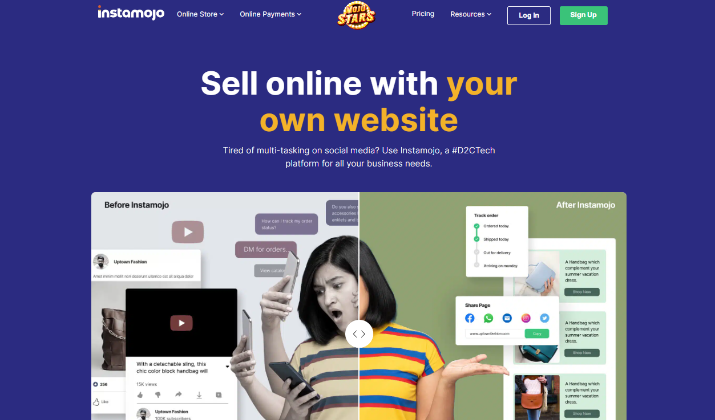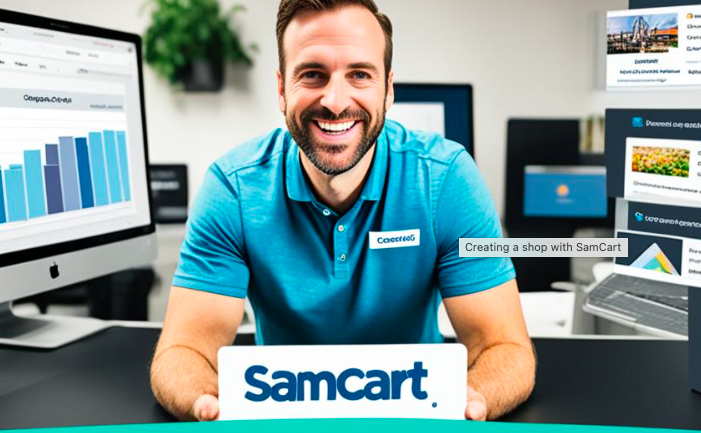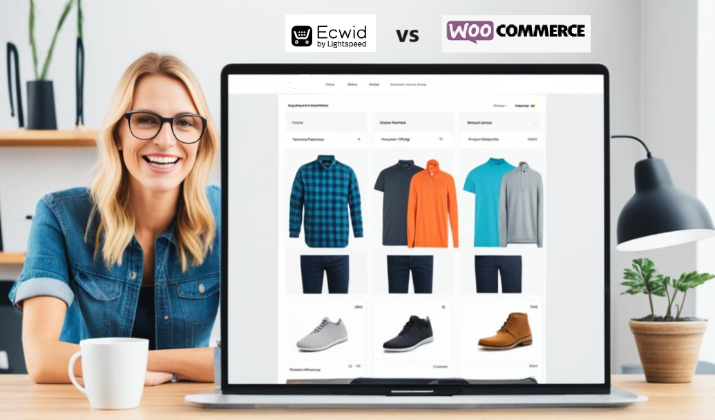Are you unsure of which ecommerce platform to choose for your business?
Welcome to a comprehensive comparison of Shopify vs Instamojo.
Join us as we dive into the main features, pricing, integrations, and other features of these two ecommerce platforms. We will also discuss their pros and cons and share our verdict.
By the end, you’ll have all the information required to make an informed decision.
Let’s begin.
Introduction
Shopify
Shopify is a cloud-based, multi-channel ecommerce platform that enables merchants to design, manage, and sell products across various sales channels like web and mobile storefronts, social media, physical retail locations, and marketplaces.
It caters to small and medium-sized businesses and offers tools for managing products, inventory, customer relationships, orders, payments, shipping, and analytics.
Some key features include:
- Inventory management lets you keep track of your products’ stock levels. You can make changes when necessary.
- With Shopify, you can create different variants of your products. This includes options like size, color, and material.
- It’s easy to import or export product data with Shopify. This makes migrating from other platforms a breeze.
- Shopify supports multiple languages. This helps you reach more people around the world.
- The platform lets you use SEO-friendly product tags. This improves how well your store shows up in search results.
- The platform allows customization through themes, apps, and integrations, offering flexibility for businesses to address their unique needs.
Shopify’s ecosystem connects sellers, developers, business experts, and shoppers, making entrepreneurship accessible to a wide range of individuals, from self-made influencers to established brands.
Shopify themes play a crucial role in determining the look, feel, and functionality of online stores, built using Shopify’s theme templating language, Liquid, along with HTML, CSS, JavaScript, and JSON.
Developers can create custom themes, customize existing ones, or build themes for the Shopify Theme Store, enhancing the online shopping experience for merchants and customers alike.
Also read: Shopify vs Shopware
Try Shopify free followed by first month at just $1. No credit card required. Limited Time Offer.
Instamojo
Instamojo is a leading provider of cloud-based solutions for ecommerce businesses.
The key features of Instamojo include:
- Ability to sell products and services online on any channel with just a website link
- There are no charges for setup or keeping it up. This makes Instamojo a budget-friendly choice.
- It lets customers pay with debit and credit cards. This makes transactions easier for everyone.
- You can make professional invoices for your customers with Instamojo. It’s simple and easy to do it.
- There’s also support for payments that happen regularly. This can be useful for subscription services.
- Instamojo keeps you updated with detailed reports and analytics. This helps you understand your business’s performance.
Instamojo offers priority support to help businesses get their website up and running quickly. It’s also easy to use with no hidden fees.
Overall, Instamojo is a comprehensive platform enabling ecommerce for small businesses in India with its integrated payments, shipping, analytics and other tools.
Check out: Sellfy vs Gumroad
Ease of Use
Shopify and Instamojo are both relatively easy to use for setting up an online store, but Instamojo may have a slight edge in terms of simplicity.
Instamojo is designed with ease of use and simplicity in mind, providing a “plug-and-play” setup where you can get a free online store with a payment gateway integrated. It has a clean interface and is super simple to use, even for beginners.
Shopify also has a user-friendly interface that makes it easy for beginners to set up and manage their online stores without much technical knowledge. However, it has a steeper learning curve compared to Instamojo.
While both ecommerce platforms are quite easy to use, Instamojo stands out for its extreme simplicity, making it a great choice for small businesses and individual sellers just getting started with ecommerce.
Explore: Sellfy vs Stan Store
Themes & Design
Shopify and Instamojo offer different approaches when it comes to themes and design for online stores:
Shopify provides a wide range of professionally designed themes that are mobile-responsive and highly customizable.
There are over 100 themes available, both free and paid, that allow you to create a unique look for your store.
Shopify’s themes are known for their clean, modern designs that showcase products effectively.
In contrast, Instamojo has a more limited selection of around 19 themes for premium users to choose from. However, the themes are still well-designed and mobile-friendly. Some popular Instamojo themes include:
- Florencia – A clean, minimal theme with a modern feel and templatized sections for images and text
- Accent – An earthy, professional theme that focuses on large product images and longer homepages
- Compass – A simple, fun theme that balances product images and descriptions equally
For free Instamojo stores, there are only two theme options – Cipher and Anchor. These provide a basic look to get started.
In short, Shopify offers more flexibility and customization with its extensive theme library, while Instamojo has a smaller but still attractive selection of themes, especially for premium users.
The right choice depends on your specific design needs and preferences.
Read this too: Shopify vs mijndomein
Product Management
Shopify and Instamojo offer different approaches to product management:
Shopify
Shopify provides robust product management features that allow you to easily add, edit, and organize products.
Some key capabilities include:
- Managing product variations, inventory, and pricing
- Importing and exporting product data in bulk
- Categorizing products into collections
- Applying SEO tags and descriptions to optimize product pages
Shopify also supports selling digital products and managing product kits and bundles.
Try Shopify free followed by first month at just $1. No credit card required. Limited Time Offer.
Instamojo
In contrast, Instamojo has a more streamlined approach to product management. While it allows you to add products and variants, the feature set is more basic compared to Shopify.
Instamojo is designed to be simple and easy to use, especially for small businesses and individual sellers.
Some key Instamojo product management features include:
- Adding product images, descriptions, and pricing
- Managing inventory levels
- Categorizing products into collections
However, Instamojo lacks advanced capabilities like bulk import/export, SEO optimization, and digital product support.
As evident, Shopify offers a more comprehensive and flexible product management system, while Instamojo prioritizes simplicity and ease of use.
Also read: Shopify vs Fourthwall
Integrations & Apps
Shopify
Shopify has a vast ecosystem of over 6,000 apps that allow you to extend the functionality of your online store. These apps cover a wide range of categories such as marketing, sales, customer service, and inventory management. Some popular Shopify apps include:
- Oberlo – for finding and importing products to sell
- Kit – an AI marketing assistant
- Smile.io – for building a loyalty program
- Yotpo – for collecting reviews and user-generated content
Shopify’s app store makes it easy to find and install apps to meet your specific business needs.
Check out: Neto vs Shopify For B2B
Instamojo
In contrast, Instamojo has a more focused app ecosystem tailored for small businesses. It has a smaller selection of apps compared to Shopify.
However, the available apps still cover key areas like marketing, accounting, and shipping. Some examples of Instamojo integrations include:
- Mailchimp – for email marketing
- Zoho Books – for accounting and invoicing
- Shipway – for shipping and logistics
Instamojo also offers a Shopify integration that allows you to accept payments through Instamojo’s payment gateway on your Shopify store.
Shopify offers a vast and diverse app ecosystem, while Instamojo has a more focused selection of apps and integrations geared towards small businesses. The ideal choice depends on your specific needs and the types of apps you require to run your online store.
Explore: GoDaddy vs Shopify
Marketing and SEO
Shopify
Here are some ways in which Shopify’s range of built-in marketing tools and SEO features help drive traffic and sales:
- Supports SEO-friendly URLs, meta tags, and descriptions for optimizing product and category pages
- Offers email marketing and SMS capabilities through apps like Kit to send targeted campaigns
- Allows running discount codes and gift cards to incentivize purchases
- Integrates with Facebook, Instagram, and other social channels for social selling
Shopify also has a large ecosystem of marketing apps that provide additional functionality like loyalty programs, reviews, and abandoned cart recovery.
Try Shopify free followed by first month at just $1. No credit card required. Limited Time Offer.
Instamojo
In contrast, Instamojo has a more streamlined set of marketing and SEO features:
- Provides SEO-friendly URLs and sitemaps to improve organic discovery on Google
- Enables adding meta information to product pages and other pages
- Supports Google Shopping content APIs for better visibility in product searches
- Allows running ads on your online store
- Offers email and SMS marketing capabilities to engage customers
Instamojo’s marketing tools are designed to be easy to use, especially for small businesses.
Read this too: Shopify vs Salla
Transaction Fees
Instamojo does not charge any setup or maintenance fees. Its transaction fees for various plans are as follows:
- Lite: 5% + ₹3 per transaction
- Starter: 5% + ₹3 per transaction
- Growth: 2% + ₹3 per transaction
However, Shopify has a tiered pricing structure for transaction fees based on the plan:
- Basic: 2.9% + 30¢ per transaction
- Shopify: 2.7% + 30¢ per transaction
- Advanced: 2.5% + 30¢ per transaction
- Shopify Plus (Enterprise): Custom pricing
Also read: Ecwid Coupon Code
Pros & Cons
Pros of using Shopify
- Ease of use: Shopify has a user-friendly interface and straightforward setup process, making it a great choice for beginners. The drag-and-drop website builder allows you to customize your store without any coding knowledge.
- Selection of themes: Shopify offers a wide selection of professionally designed, mobile-responsive themes to choose from. While the themes are highly customizable, some users may find the design options limiting.
- App ecosystem: Shopify has a vast app store with over 6,000 apps to extend the functionality of your store. Apps cover areas like marketing, sales, customer service, and more.
- Marketing and SEO features: Shopify provides built-in SEO features like editable meta tags and descriptions. It also offers email marketing and social selling capabilities.
- Hosting and security: Shopify handles hosting and security for your online store, ensuring it’s always online and protected. The checkout process is encrypted for secure transactions.
- 24/7 support: Shopify offers around-the-clock customer support via email, live chat, and phone. There’s also an extensive knowledge base and active community for self-help.
Cons of using Shopify
- Pricing: Shopify’s pricing plans start at $29/month, which some users find expensive. Transaction fees also apply if not using Shopify Payments.
- Customization: While Shopify themes are customizable, some users feel limited in their ability to achieve a truly unique design.. Extensive customizations may require coding knowledge.
- No email hosting: Shopify does not provide email hosting, so you’ll need to use a third-party email service.
- Content management: Shopify’s content management system is not as robust as some other platforms, making it tedious to manage content like blog posts.
- Difficult exit: If you decide to leave Shopify, it can be difficult to migrate your store to another platform due to limited export options.
Shopify is an excellent choice for most online businesses, especially those new to ecommerce, due to its ease of use, design flexibility, and powerful features.
However, the pricing and some limitations around customization and content management may be drawbacks for some users.
Check out: Ecwid vs Squarespace
Try Shopify free followed by first month at just $1. No credit card required. Limited Time Offer.
Pros of choosing Instamojo
- Ease of use: Instamojo is designed to be very simple and easy to set up, even for beginners. The interface is clean and intuitive, allowing you to quickly create an online store and start accepting payments.
- Payment options: Instamojo supports a variety of payment methods including UPI, debit/credit cards, net banking, and wallet. This provides flexibility for customers to pay using their preferred method.
- No setup fees: Instamojo does not charge any setup or maintenance fees. You only pay a small per-transaction fee when you receive payments.
- Smooth Payouts: Instamojo facilitates smooth and secure transactions, with payments being received quickly and reliably.The platform provides useful insights into sales data.
Cons of choosing Instamojo
- High Transaction Fees: Instamojo charges a relatively high per-transaction fee of 2-5% plus ₹3. This can add up for businesses with high sales volumes.
- Limited Payment Options: While Instamojo supports popular payment methods, it lacks support for international payments which may be a drawback for some businesses.
- Inconsistent Customer Support: Some users have reported issues with Instamojo’s customer support being slow to respond or unable to resolve certain problems. The support quality seems to be inconsistent.
- Lacking Advanced Features: Compared to platforms like Shopify, Instamojo has a more limited set of features for managing an online store. The ecommerce functionality is basic and may not meet the needs of more complex businesses.
- Refund Issues: A few users have complained about delays in processing refunds or difficulties getting refunds from Instamojo. This can be frustrating for customers.
Instamojo is a simple and affordable option for Indian businesses looking to start selling online and accepting payments. However, the high transaction fees, limited features, and inconsistent support may be drawbacks for some.
Explore: ClickFunnels vs Shopify
Conclusion
The choice between Shopify and Instamojo comes down to your business needs. Shopify offers a wider range of services for all types of businesses. Plus, it has many features and tools for ecommerce.
On the other side, Instamojo is simpler and focused on payment gateways. It’s perfect for small businesses and individuals. If you are based out of India, it might be a better platform to consider.
That said, when picking between these two, think about what your business requires. Compare their features, prices, and how well they connect with other services. This will help you pick the right platform.
















